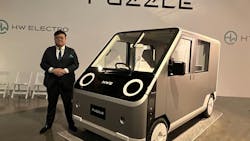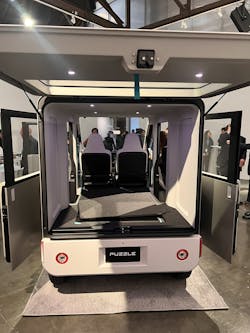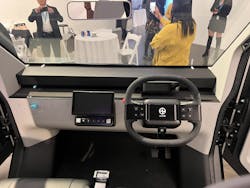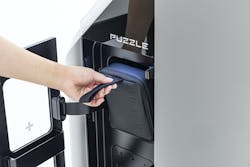Japanese-based HW Electro unveils electric cargo van for North American market
NEW YORK—Last-mile deliveries are like fitting the last piece into the puzzle of the supply chain, and the designers of a Japanese electric cargo van believe their vehicle is the missing piece to the U.S. supply chain for light-duty fleets and services.
In front of a group of automotive and commercial fleet media, HW Electro, a Japanese-based electric vehicle manufacturer, revealed its newest vehicle to the North American market, the HW Electro Puzzle. The Puzzle is a commercial van that maximizes cargo space while emitting no greenhouse gases. It was designed with three stakeholders in mind: the owner, the driver, and "everyone else."
See also: Zap! Depot operations show electric truck potential growing
For the owner
During the launch, the Puzzle's senior designer, Ivo ter Hennepe, said when it comes to vehicle choice, fleet owners care about efficiency and cargo space for their goods. This is why the Puzzle features a cube-like shape, complete with flat surfaces and 45- and 90-degree angles. Unlike other cargo vans that feature sloped body panels near the roof, the Puzzle's side body and roof panels are completely flat, optimizing the interior space to accommodate more boxes, more packages, or other cargo.
The Puzzle's passenger seat also folds, which accommodates longer cargo items. Once folded, the passenger seat also acts as a work surface for the driver.
For the driver
Drivers want a comfortable and stress-free workspace, and the Puzzle offers a "simple, modern, utilitarian aesthetic" to accomplish this, ter Hennepe explained. The Puzzle features a streamlined cockpit with few buttons and few distractions.
Drivers can further ensure their comfort needs are met through the Puzzle's pegboard-like interior door and dash panels. This pegboard-style design allows drivers to add or remove accessories, such as cupholders and storage compartments available to order through HW Electro, to their liking. Because of the removable nature of these accessories, drivers can move them from the Puzzle to their home or from Puzzle to Puzzle.
See also: How to mitigate drivers' top concerns
HW Electro also offers its management platform, My HWE, available on the Puzzle's center infotainment screen. The AI-powered platform helps drivers and fleet managers improve delivery optimization, helps with cargo management, and includes disaster support.
The Puzzle also features multiple AC power outlets and USB outlets throughout the vehicle's interior, ensuring power is available no matter the application.
An exterior panel on the vehicle's driver's side houses the charging ports and additional AC power outlets for the operator. A panel on the passenger side of the vehicle houses features for the final stakeholder: everyone else.
For the public
The folks at HWE said the vehicle's ability to "connect" to society sets it apart from other EVs in the commercial space. That societal connection sounds complicated—and perhaps intrusive—but the way the Puzzle provides the connection is simpler than one might think. The idea of this societal connection came to HWE CEO Hsiao Weicheng after seeing the devastation of his community from the Great East Japan Earthquake of 2011, according to the HW Electro website. At the time, he wished for mobile power source access. From there, the idea grew to become the Puzzle commercial EV.
The panel on the passenger side of the Puzzle allows it to connect to society. HWE calls it the Public Panel. It reveals a first aid kit, USB ports, and additional AC outlets—all for public use in emergencies. Ter Hennepe said it's available to "anyone and everyone. " The panel also features "completely free and open" WiFi connectivity for public use.
When an emergency occurs, "think, earthquake," ter Hennepe said, Puzzle operators will be equipped to help. This is because each Puzzle includes a crowbar concealed under the floorboard at the rear of the cargo van.
Further, the Puzzle's USB and power outlets are all powered by solar panels on the vehicle's roof, making the Puzzle a handy source of power when electricity isn't available.
Pieces of the Puzzle
The creative director for the Puzzle, Ryuhei Ishimaru, said the EV was designed with what the team calls a Puzzle Design Approach. This approach maximizes the number of recurring parts used in its manufacturing, "from entire body parts to small details, like interior panels, side mirrors, and daytime working lights," Ishimaru told the group.
Second, the design approach prioritizes function, with flat and flush surfaces and those 90- and 45-degree angles that maximize cargo space. This Puzzle Design Approach helps HWE design more sustainably and reduces manufacturing costs.
"We focused highly on the cost of production for this vehicle, and also, we are very proud of how much cargo we can fit in this vehicle," Weicheng said.
Weicheng told FleetOwner through a translator that HWE's target application case with the Puzzle is last-mile delivery. They will eventually expand to other markets and mobile services, such as mobile barbers and mobile pet groomers.
"By taking these steps, we are building a society that is different from now," Weicheng told FleetOwner. "Once we establish this connectivity between people, we will be able to provide more emergency services. Our ideal society will be that everybody's connected so when there's an emergency, all the individual vehicles can be the emergency vehicles to service society."
The HWE Puzzle is powered by a lithium iron phosphate battery that offers a range of roughly 125 miles on one charge. Production is expected to begin in 2024, with deliveries in 2025.
See also: Three Ps can help your truck fleet deliver on time this holiday season
Click "View Slideshow" at the top of the page to view a photo gallery of the Puzzle.
About the Author
Jade Brasher
Senior Editor Jade Brasher has covered vocational trucking and fleets since 2018. A graduate of The University of Alabama with a degree in journalism, Jade enjoys telling stories about the people behind the wheel and the intricate processes of the ever-evolving trucking industry.




